Related Research Articles
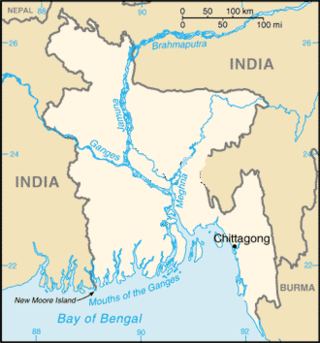
The 2007 Chittagong mudslides occurred in the port city of Chittagong in south-eastern Bangladesh. On 11 June 2007, heavy monsoon rainfall caused mudslides that engulfed slums around the hilly areas of the city. Experts had previously warned the increasing likelihood of landslides due to the Bangladesh government's failure in curbing the illegal hill cutting taking place in Chittagong.
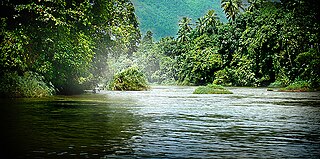
The Kelani River is a 145-kilometre-long (90 mi) river in Sri Lanka. Ranking as the fourth-longest river in the country, it stretches from the Sri Pada Mountain Range to Colombo. It flows through or borders the Sri Lankan districts of Nuwara Eliya, Ratnapura, Kegalle, Gampaha and Colombo. The Kelani River also flows through the capital of Sri Lanka, Colombo, and provides 80% of its drinking water.
Pusweli Oya is a major tributary of Kelani Ganga river in Sri Lanka.
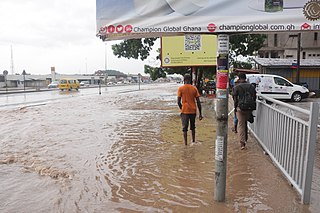
The 2009 West Africa floods are a natural disaster that began in June 2009 as a consequence of exceptionally heavy seasonal rainfall in large areas of West Africa. Several rivers, including the Pendjari, Niger, Volta and Senegal rivers, broke their banks, causing destruction of houses, bridges, roads and crops. The floods are reported to have affected 940,000 people across 12 countries, including Burkina Faso, Benin, Ghana, Niger, Senegal, Guinea, and caused the deaths of at least 193 people. In Burkina Faso, one of the most affected countries, 150,000 people fled their homes, mostly in the capital Ouagadougou where rainfall in one day was equal to 25% of normal annual rainfall for the whole country.

The 2010 China floods began in early May 2010. Three hundred and ninety-two people died, and a further 232 people were reported missing as of June 30, 2010, including 57 people in a landslide in Guizhou. Fifty-three of the deaths occurred from the flooding and landslides between May 31 and June 3, and 266 deaths occurred between June 13 and June 29. Four hundred and twenty four people were killed by the end of June, including 42 from the Guizhou landslide; 277 more were killed and 147 were missing in the first two weeks of July, bringing the death toll as of August 5 to 1,072. A landslide in early August in Gansu killed at least 1,471 people and left 294 missing. In total, the flooding and landslides killed at least 3,185 people in China by August 31. More than 230 million people in 28 provinces, municipalities, and regions, especially the southern and central provinces and regions of Zhejiang, Fujian, Jiangxi, Hubei, Hunan, Guangdong, Guangxi, Chongqing Municipality, Gansu, Sichuan, and Guizhou, and the northeastern province of Jilin were affected, while at least 4.66 million people were evacuated because of the risk of flooding and landslides in the latter half of June. By early August, over 12 million people were evacuated, and that number rose to 15.2 million by August 31.

Deep Depression ARB 02 was a weak tropical cyclone which brought heavy rains and flooding to the Indian state of Gujarat in June 2015. It was the third tropical cyclone and second deep depression of the 2015 North Indian Ocean cyclone season.

Cyclonic Storm Roanu was a relatively weak tropical cyclone that caused severe flooding in Sri Lanka and Bangladesh during May 2016. It is the first tropical cyclone of the annual cyclone season. Roanu originated from a low-pressure area that formed south of Sri Lanka, which gradually drifted north and intensified into a cyclonic storm on 19 May. However, wind shear and land interaction caused it to weaken slightly, before reintensifying as it accelerated towards the coast of Bangladesh.
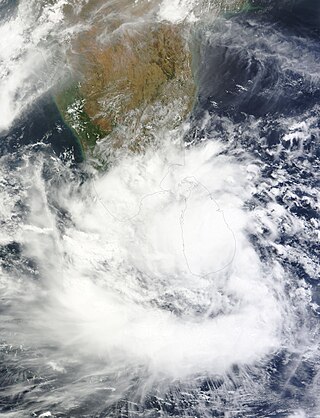
Beginning on 14 May 2016, a low pressure area over the Bay of Bengal caused torrential rain to fall across Sri Lanka, causing floods and landslides which affected half a million people. As of 25 May 2016 the death toll was 101 with 100 missing.
The 2017 Sri Lanka floods resulted from a heavy southwest monsoon, beginning around 18 to 19 May 2017. Flooding was worsened by the arrival of the precursor system to Cyclone Mora, causing flooding and landslides throughout Sri Lanka during the final week of May 2017. The floods affected 15 districts, killed at least 208 people and left a further 78 people missing. As of 3 June, 698,289 people were affected, while 11,056 houses were partially damaged and another 2,093 houses completely destroyed. According to Al Jazeera, about 600,000 people have been displaced due to the floods.
2018 Sri Lanka floods and landslides caused from an annual heavy southwest monsoon beginning around 19 May. As of 26 May 2018; the monsoon floods affected in about 19 districts, killed at least 21 people, about 150, 000 people were affected and further left approximately 23 people missing. The death casualties were reported from 22 May onwards in the provinces including South, Northwest, North and East. About 4 people were reported dead due to lightning, 5 people were killed due to floods and lightning, 8 people died due to drowning and further left 4 people dead resulting from fallen trees. The DMC report claimed about 400, 000 people have been displaced to safer locations. About 105 houses were reported to have fully damaged and over 4832 houses have been partially damaged.
In mid-March 2019, monsoonal downpours caused widespread flooding and landslides across South Asia.
The 2019 floods and landslides in Sri Lanka were the floods which were caused from heavy torrential rainfalls during September 2019. As of 26 September 2019; the monsoon floods affected in about 13 districts, killing at least 2 persons, injuring 6 people and about 116, 000 people are affected. One casualty was reported in the Galle District and the other one was reported in Kolonnawa, where a teenager drowned in the flood water. About 282 houses were reported to have been damaged mainly in Galle and Matara while 22 houses out of 150 houses were completely destroyed in the two districts.
The 2020 East Africa floods were a natural disaster in Rwanda, Kenya, Somalia, Burundi, Ethiopia, Uganda, Democratic Republic of Congo, Djibouti and Tanzania, affecting at least 700,000 people. They began when excessive rains began falling in March, leading to massive flooding and landslides. They caused more than 430 deaths, notably in Kenya and Rwanda. In the fall another round of floods hit the African Sahel.

In 2021, Niger has been affected by subsequent floods due to heavy rains, causing several deaths and widespread damage nationwide. Niamey is the most affected area. At least 62 people died, 60 were injured and 105,690 individuals have been affected by the floods. Most fatalities were reported in Maradi Region with 18 deaths.
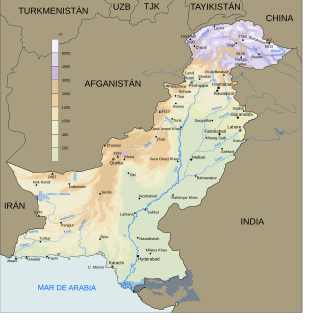
In 2016 Pakistan experienced higher rainfall than normal (10-20%), especially in the pre-monsoon season. Heavy monsoon rains are common in the region. This led to multiple periods of flooding, landslides, and damage particularly in Northern Pakistan. The Swat River overflowed and multiple landslides occurred around Pakistan including in Khyber Pakhtunkhwa, Gilgit-Baltistan, Azad Jammu, and Kashmir.
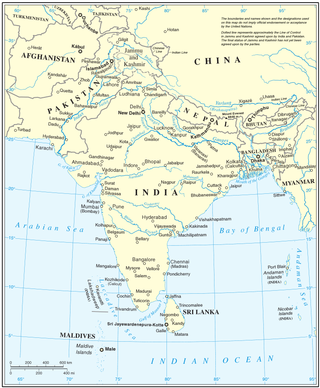
From January to October 2022, excessive rainfall and widespread monsoon flooding occurred in the South Asian countries of Afghanistan, Bangladesh, India, Nepal, Pakistan, and Sri Lanka. It has become the region's deadliest floods since 2020, with over 3,700 people dead.

After over 6,500 people died in flooding in 2020, monsoon floods hit South Asia again in 2021.

Monsoon floods have affected South Asia from May to December 2019.
References
- ↑ "Thousands homeless as Sri Lanka floods death toll hits 17". France 24. 7 June 2021. Retrieved 7 June 2021.
- ↑ Welle (www.dw.com), Deutsche. "Sri Lanka: Monsoon rains cause deadly flooding | DW | 07.06.2021". DW.COM. Retrieved 7 June 2021.
- ↑ "Adverse weather affects over 240,000, 14 dead". Daily News. Retrieved 6 June 2021.
- ↑ IANS. "14 killed in Sri Lanka floods, landslides". Khaleej Times. Retrieved 6 June 2021.
- ↑ "Sri Lanka Teaches the World How Not to Respond to COVID-19". thediplomat.com. Retrieved 6 June 2021.
- ↑ "You are being redirected..." floodlist.com. Retrieved 6 June 2021.
- ↑ "4 dead, over 42,000 affected by heavy rains, flooding in Sri Lanka - Xinhua | English.news.cn". www.xinhuanet.com. Retrieved 6 June 2021.
- ↑ "Colombo hit by heavy rain - Xinhua | English.news.cn". www.xinhuanet.com. Retrieved 6 June 2021.
- ↑ "Floods and mudslides kill 6, another 5 missing in Sri Lanka". Washington Post. ISSN 0190-8286 . Retrieved 6 June 2021.[ permanent dead link ]
- ↑ "6 dead, 5 missing as floods and mudslides hit Sri Lanka". Global News. Retrieved 6 June 2021.
- ↑ "Death toll in Sri Lanka floods, mudslides rises to 14". CNA. Retrieved 6 June 2021.
- ↑ "Death toll in Sri Lanka floods, mudslides rises to 14". Washington Post. ISSN 0190-8286. Archived from the original on 6 June 2021. Retrieved 7 June 2021.
- ↑ "You are being redirected..." floodlist.com. Retrieved 7 June 2021.
- ↑ "Water level of Kelani Ganga on the rise, Flood warning issued". Daily News. Retrieved 6 June 2021.
- ↑ "Flood warning issued to people around Maha Oya".
- ↑ "Navy relief teams continue to reach out to people affected by floods". Daily News. Retrieved 6 June 2021.
- ↑ "Sri Lanka Air Force monitors flood affected areas".